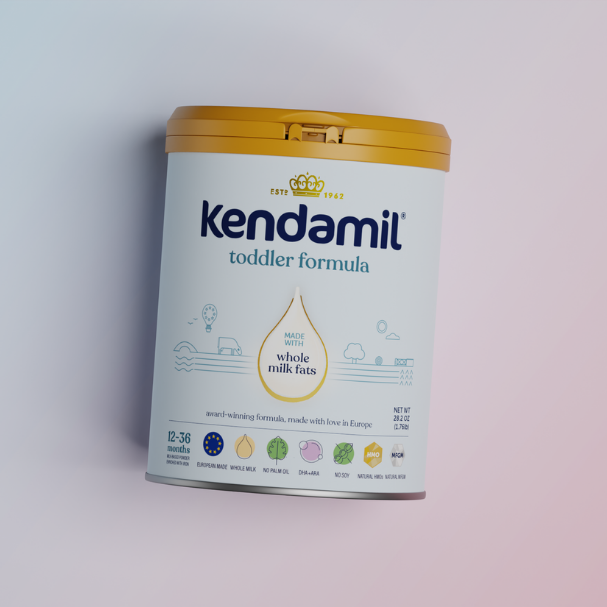Making sure baby is fed and happy is at the top of every new parent’s list. But when baby starts to excessively spit up their feeds or is suffering endlessly with colic it can start to feel overwhelming. Luckily there are many options these days when it comes to formulas designed for sensitive tummies. Here we’ll identify what’s to be expected when it comes to common digestive issues and at what point you may want to consider switching to a more gentle formula.
Common Digestive Problems: What’s ‘Normal’ and What’s Not
During the first six months of life babies are constantly developing and growing stronger. When baby is born their digestive system isn’t mature. When it comes to swallowing their milk in particular, the valve between the stomach and the esophagus is usually quite floppy and may not fully close in many newborn babies. This means their feeds can easily come back up. Babies must also develop a stronger, more mature mucus lining around their gastrointestinal tract in order to protect it from microbes or contaminants. It won’t be until baby hits the 6-9 month milestone that their digestive system starts to mature and most babies grow out of digestive issues such as reflux by the age of 12 months.
So now we understand that most babies are likely to experience some kind of digestive issues as their digestive systems mature, let’s get into the symptoms of the most common digestive problems:
Reflux
If your baby continuously spits-up some of their milk after a feed they may be suffering with reflux. They may also gag and choke while they feed. As we saw earlier the valve between their stomach and the esophagus isn’t developed when they are newborn, so milk can travel back up the esophagus quite easily, which can cause the esophagus to feel irritated. Symptoms of reflux include:
- Sudden crying when feeding or may cry throughout a feed
- Gagging or choking during feeds, may also refuse feeds
- Spitting up milk during or after feeds on a regular basis
- Struggling to gain weight
- Waking up at night more than usual
- Baby experiences a lot of hiccups or coughing
Another potential cause for reflux can be the presence of an oral tie. For example, when baby has tongue-tie, baby will have an increased risk of reflux. The tongue is restricted and as a result does not create a good seal during feedings causing extra air to be swallowed. This extra air can "bubble up" and carry liquid back up from the stomach and manifest as reflux. Speak with an oral tie professional about evaluating your baby for ties and discuss possible tie release procedures if applicable.
Colic
For most babies, colic seems to rear its ugly head when baby is around 3 weeks old, worsening at 6 weeks old. 10-20% of visits to the pediatrician during babies first few weeks are colic related. It can be very distressing for baby and parents alike especially when baby is crying for hours on end and nothing seems to soothe them. Colic is estimated to affect 5-40% of babies worldwide. Whilst some recent research has shown the potential causes of colic being linked to the gut flora of newborns, in most cases symptoms do start to ease as babies hit their 3 month milestone. Here are the symptoms to watch out for:
- They cry for more than 3 hours a day, more than 3 days a week for at least 3 weeks and aside from this they’re otherwise healthy
- It’s difficult to soothe and calm your baby
- They clench their fists while crying
- They go red in the face while crying
- They’re bringing their knees up to their tummy or arch their back when crying
- You can hear their tummy rumbling or they’re very gassy
Constipation
Constipation in babies can be difficult to recognize, as they may not have regular bowel movements like adults do. This is just because their body is learning how to cope with digesting new things. For formula fed babies, it's normal for baby to become constipated when they start formula as it is not as easy to digest as breast milk is. If your baby’s formula contains palm oil, you may want to consider switching as palm oil has been linked to causing harder stools in babies. Signs of constipation in babies include:
- Dry, hard poop that can look lumpy and can be on the larger side
- Unusually smelly gas and poop
- Crying or discomfort during or after passing a bowel movement
- Pooping less than 3 times a week
- Baby’s tummy might feel tight
- Baby might be grumpier than usual and lack energy
Let’s Talk Poop
When it comes to the number of poops a day and what is deemed a ‘normal’ color and consistency, every baby is different. Some babies may poop several times a day, while others may only poop once every few days. The color of baby’s poop will also vary from tan to yellow to brown to greenish and its color and consistency can change depending on their diet, the introduction of a new formula, when you start to wean and their health. Breastfed babies tend to have soft, yellow, and sometimes seedy poop, whereas formula fed babies tend to have firmer, more formed poop that is usually mustard or greenish colored. A looser stool is also common and can be totally normal. However, sometimes runny poops aren't always normal if other symptoms are present, such as:
- Frequent bowel movements
- Mucus or blood in poop
- Signs of dehydration (decrease in wet diapers)
- Stomach cramps
- Fever
- Cramping
These symptoms can be a result of an infection - viral or bacterial, as well as CMPA or lactose intolerance. Please speak with a medical professional if you think your baby is experiencing diarrhea along with one of the symptoms above.
Allergies
Symptoms of a food allergy or intolerance in babies can include diarrhea, a rash, colic, or eczema. If your baby has a milk allergy or lactose intolerance, they may also have symptoms such as vomiting, reflux, or bloating. If you suspect your baby has a food allergy or intolerance, it's important to speak to your pediatrician who can further testing.
Cow's milk protein allergy (CMPA) affects between 2-6% of children in the US, mainly affecting children in their first year. About 50% of children have been shown to resolve CMPA by the time they turn 1 year (1). Symptoms of CMPA can include digestive issues, such as fussiness, vomiting and diarrhea. If your baby is diagnosed by your pediatrician to have a cow's milk protein allergy (CMPA) or is otherwise sensitive to cow's milk, we recommend discussing with your pediatrician the infant formula most suited to your baby’s needs. Goat milk formulas are not recommended for children with a confirmed diagnosis of cow milk protein allergy (CMPA).
Could Goat Milk Formula Be The Answer?
There are many tricks and hacks to help ease the digestive issues of your baby and for formula fed babies that could mean switching to a gentler formula. For babies suffering with digestive issues goat milk formula may offer a gentler, natural alternative. So let’s dig into why?
- Goat milk predominantly contains A2 beta-casein proteins, which are more similar to the proteins found in breastmilk and may be easier to digest for sensitive babies.
- Goat is a naturally casein protein-dominant milk, so Kendamil intentionally adds goat whey to rebalance the protein ratio to be whey dominant, matching the ratio of breastmilk and helping baby digest faster.
- When baby digests their milk it reacts with their stomach acid, creating curds. Cow’s milk naturally forms slightly larger, firmer curds, whereas goat milk creates softer, smaller and looser curds, just like breast milk curds. For babies with digestive issues and sensitive tummies, the softer curds formed by goat’s milk may help them to digest quicker and absorb their nutrients more efficiently.
- Goat milk contains naturally high levels of oligosaccharides (in other words, natural prebiotics, similar to those found in breast milk). The oligosaccharides in goat milk help promote the growth of beneficial, healthy bacteria and limit the ability of harmful bacteria to attach to intestinal cells.
- Studies have shown that the frequency and consistency of stools of infants fed goat infant formula were more similar to those who were breastfed versus cow infant formula (2). The fat present in goat milk is more easily absorbed than other milks.
How To Transition Baby From Another Formula To Kendamil Goat
Change is tricky for everyone and our little ones are no different. But if you think goat milk could be the solution to your baby’s digestive problems then our Goat Infant Formula could be the answer. To help your little one transition and adjust to a different texture or taste, a slower phased approach can help them get used to it. Most babies will need up to a week to transition to a new infant formula.

Around 25-40% of infants are reported to have feeding problems, mainly colic, vomiting, slow feeding and refusal to eat according to reports (3), so it is more common than you think. Of course in the moment it’s easy to feel despair when your little one is so agitated and upset, but in time as a baby’s digestive system matures, most will grow out of these common feeding problems. Always seek support from your pediatrician when you’re concerned about baby’s weight gain and symptoms.
To learn more about Kendamil’s Goat Infant Formula click here.
For more advice on common feeding problems head to our blog here. You can also learn more about the meaning behind your baby’s poop here.
Check out the American Academy of Pediatrics have some useful tips on how to relieve symptoms of colic here. They also have a helpful information sheet on reflux here.
(1) Cow's milk protein allergy in children: a practical guide. National Library of Medicine. 2010 Jan 15. doi: 10.1186/1824-7288-36-5
(2) Association of infant feeding practices in the general population with infant growth and stool characteristics. 2011 Aug 31. National Library of Medicine. doi: 10.4162/nrp.2011.5.4.308
(3) Feeding problems of infants and toddlers. Anne-Claude Bernard-Bonnin, MD, FRCPC. National Library of Medicine. 2006 Oct 10; 52(10): 1247–1251.














